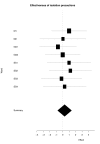Assessing the role of undetected colonization and isolation precautions in reducing methicillin-resistant Staphylococcus aureus transmission in intensive care units
- PMID: 20158891
- PMCID: PMC2829569
- DOI: 10.1186/1471-2334-10-29
Assessing the role of undetected colonization and isolation precautions in reducing methicillin-resistant Staphylococcus aureus transmission in intensive care units
Abstract
Background: Screening and isolation are central components of hospital methicillin-resistant Staphylococcus aureus (MRSA) control policies. Their prevention of patient-to-patient spread depends on minimizing undetected and unisolated MRSA-positive patient days. Estimating these MRSA-positive patient days and the reduction in transmission due to isolation presents a major methodological challenge, but is essential for assessing both the value of existing control policies and the potential benefit of new rapid MRSA detection technologies. Recent methodological developments have made it possible to estimate these quantities using routine surveillance data.
Methods: Colonization data from admission and weekly nares cultures were collected from eight single-bed adult intensive care units (ICUs) over 17 months. Detected MRSA-positive patients were isolated using single rooms and barrier precautions. Data were analyzed using stochastic transmission models and model fitting was performed within a Bayesian framework using a Markov chain Monte Carlo algorithm, imputing unobserved MRSA carriage events.
Results: Models estimated the mean percent of colonized-patient-days attributed to undetected carriers as 14.1% (95% CI (11.7, 16.5)) averaged across ICUs. The percent of colonized-patient-days attributed to patients awaiting results averaged 7.8% (6.2, 9.2). Overall, the ratio of estimated transmission rates from unisolated MRSA-positive patients and those under barrier precautions was 1.34 (0.45, 3.97), but varied widely across ICUs.
Conclusions: Screening consistently detected >80% of colonized-patient-days. Estimates of the effectiveness of barrier precautions showed considerable uncertainty, but in all units except burns/general surgery and one cardiac surgery ICU, the best estimates were consistent with reductions in transmission associated with barrier precautions.
Figures



